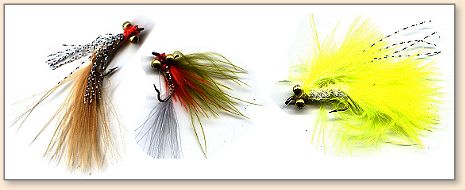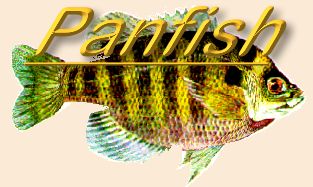|
I have been watching two things for the
past two years about catching gills and
crappies. I have done each of these several
times and wonder if it would work for you
or in different places.
For the gills I am convinced that as warmwater
fisherman that we do not use midges enough. I
have been catching a lot of gills using midges
as a dropper. I use any floating fly and tie
the midge on about 12 to 16 inches of tippet
off the bend.
The midges have been very simple to tie. I take
a size 18 to 22 hook, wrap it with thread and
then use 2 barbs off a pheasant or turkey tail
to wrap a body. A few of them I have put a small
black head on, but it has not made any difference
that I can see in catching fish. I have used a
colored pheasant and turkey feather to tie these
also. I have used Golden Pheasant tail barbs to
tie them also. They have all worked.
Most of the time I take this rig and cast it out
and just let it sit. I do this all over the pond,
not just in the shallow water. I have watched gills
come up and look at the fly for a long time before
they take it. The responses are a little faster if
there is more than one fish around. A bonus is that
many times another fish will hit the fly that was
on the surface.
I have checked the stomach contents of many gills,
after filleting them, and most of the time all I
can find is what I am assuming to be midges. Whatever
is in the stomach is very small and dark. I can't
identify them as anything else, although I am a poor
entomologist. I do find some hoppers, ants, beetles,
inch worms, mayflies, and a few other bugs, but most
of them look like midges.
I have come to the point where I rarely toss a popper
or floating bug of any sort that does not have a midge
dropper on it. Please do check your state laws to make
sure this is legal where you live. I am catching more
fish on the midges than I am on other things. If you
feel like it try this and let me know what happens.
Maybe I have weird fish here. I know they are dumb,
because I can catch them.
The second thing I am working on is with catching
crappie from about the middle of July to the late
fall. I would hook crappie but loose them. I would
see the flash of the fish hitting and then would
loose them. The few that I did get in were barely
hooked in the mouth.
I tied up a few Marabous Miss's and Streamer Nymphs
with some closed cellfoam for an under body. This
let the flies pretty much suspend. I could
let the flies stay fairly near the canoe and
watch what happened to them. I would see the
fish come up from deeper water and roll as they
hit the fly. As I worked the fish I could see
the fly in the side of their mouth. With
the thin tissue they have it was good bye
to most of the fish.
Time to think and make some changes in how I tied
some flies. I was trying to figure out how to make
the fly lays horizontally in the water instead of
vertical. This way when the fish rolled on the fly
they would get hooked in the roof or floor of their
mouth. It is not perfect but this is what I came
up with. I put the hook in the vice and turn it
90 degrees, so the hook is horizontal. I then tie
in bead chain eyes, fairly heavy on the top of the
hook. It is easier for me to tie the eyes on the
top of the hook rather than the bottom. I then
rotate the hook 180 degrees and loosely wrap some
closed cell foam on the top of the shank. I then
super glue the eyes on and let the glue dry.

When I get to tying the pattern, I put the hook
in the vice and rotate it 90 degrees and then tie
the fly with the foam on the top of the shank and the
bead chain eyes below the shank. They don't float
exactly horizontally, but they work better than the
regular flies. I have caught a few more fish with
the flies tied this way than I did before and they
are hooked in thicker tissue. I am sending a few of
them to Joe Hyde to try to see if it helps
with his problem of the crappie getting off.
If you try either of these please let me know how it works.
Hope you can get out on the water. ~ Rick
|





